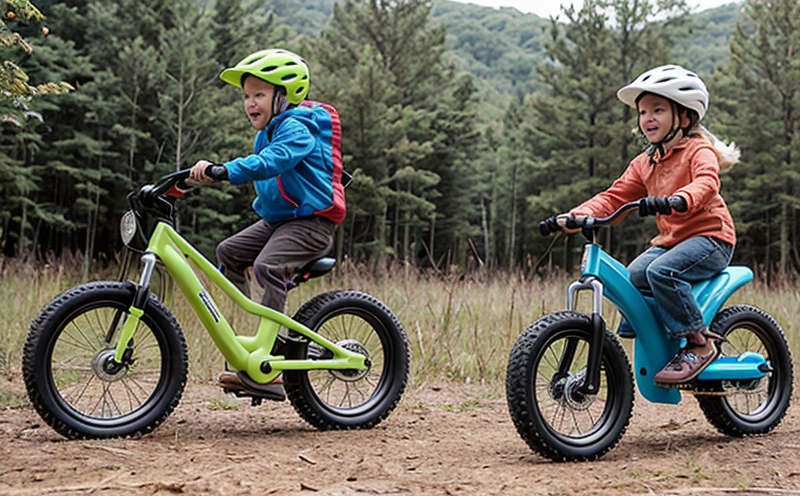ISO 8124-1 Ride-on Equipment Tip-over Stability Test
The ISO 8124 series of standards is internationally recognized for ensuring toys are safe and suitable for their intended use. Specifically, ISO 8124-1:2019 focuses on mechanical and physical properties of toys to ensure they do not pose a risk to children. One critical aspect addressed in this standard pertains to the stability of ride-on equipment, which can include scooters, pedal cars, bicycles, and other similar toys intended for outdoor use.
The ISO 8124-1 Ride-on Equipment Tip-over Stability Test is crucial for ensuring that these toys are stable enough to prevent accidents. This test assesses the stability of ride-on equipment by simulating real-world conditions, such as children mounting or dismounting the toy, which can lead to tipping and potential injury.
The testing procedure involves placing a specified load on the toy at various points where a child might stand or sit. The load is gradually increased until the toy tips over or reaches its tipping point. The test aims to ensure that the toy does not tip over under normal use conditions, thereby protecting children from potential accidents.
The apparatus used in this testing includes a calibrated platform and a weight system capable of applying incremental loads. This setup allows for precise measurement and control of the load applied to the toy. Compliance with ISO 8124-1 ensures that ride-on equipment meets safety standards, which is essential for protecting children's well-being.
The acceptance criteria for this test are based on the concept of a "tipping point." The toy must not tip over when subjected to loads equivalent to those a child might exert during normal use. This includes both static and dynamic loading conditions. Static loading simulates the weight of an adult or child standing in one place, while dynamic loading assesses how the toy behaves under moving conditions.
Compliance with ISO 8124-1 is mandatory for manufacturers aiming to sell ride-on equipment in markets that adhere to these international standards. This ensures a consistent level of safety across different regions and helps build consumer trust. By adhering to these guidelines, manufacturers can demonstrate their commitment to children's safety.
The test procedure outlined in ISO 8124-1 provides clear instructions on specimen preparation, testing setup, and data interpretation. Manufacturers are advised to follow these procedures meticulously to ensure accurate results and compliance with the standard.
Why Choose This Test
Ensures compliance with international safety standards (ISO 8124-1).
Safeguards children from potential accidents and injuries due to tip-over incidents.
Promotes brand reputation by demonstrating a commitment to child safety.
Provides clear, verifiable data that supports product design and manufacturing processes.
Simplifies the regulatory compliance process for manufacturers aiming to sell products globally.
The ISO 8124-1 Ride-on Equipment Tip-over Stability Test is essential for any manufacturer of ride-on toys. It not only ensures product safety but also enhances brand reputation and simplifies compliance with international standards.
Environmental and Sustainability Contributions
The ISO 8124 series of standards, including the Ride-on Equipment Tip-over Stability Test, contributes to environmental sustainability by ensuring that toys are designed with safety in mind. This reduces the likelihood of product recalls due to accidents, which can lead to unnecessary waste generation during disposal.
By adhering to these standards, manufacturers can ensure that their products do not pose a risk to children and contribute positively to public health. This aligns with broader sustainability goals by promoting responsible manufacturing practices and reducing environmental impact.
Use Cases and Application Examples
The ISO 8124-1 Ride-on Equipment Tip-over Stability Test is applicable in various scenarios, particularly for ride-on toys designed for outdoor use. These include scooters, pedal cars, bicycles, and similar products.
An example of a real-world application is the testing of a scooter toy intended for children aged 3 to 5 years old. During this test, the apparatus applies incremental loads at different points on the scooter to assess its stability under static and dynamic conditions. The results demonstrate that the toy meets safety standards, ensuring it does not tip over easily during normal use.
Another example involves a manufacturer of pedal cars for children aged 5 to 8 years old. By conducting this test, the manufacturer ensures that each pedal car is stable enough to prevent tipping and subsequent injuries. This contributes to the overall safety and well-being of children using these toys.





